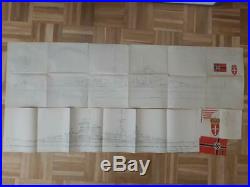
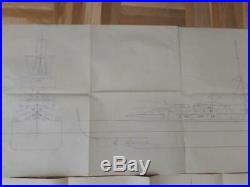
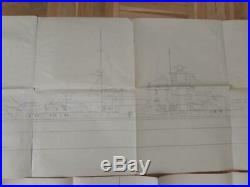
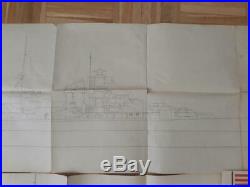
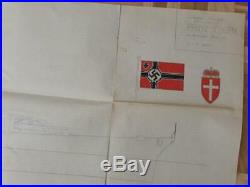
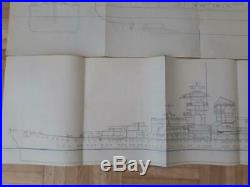
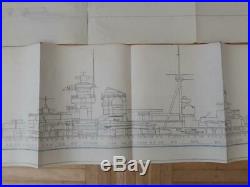
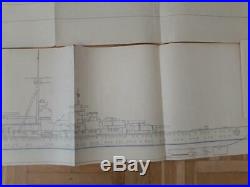
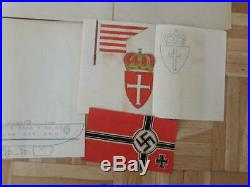
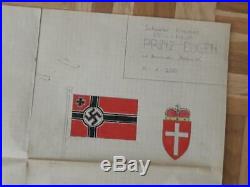
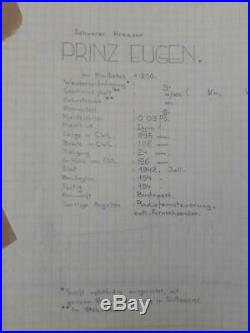

PLEASE EXAMINE CAREFULLY THE RESOLUTION PHOTOS FOR DETAILS AND POSSIBLE FAULTS!!! GERMANY WAR KRIEGSMARINE CRUISER PRINZ EUGEN LOT TWO PLAN HAND MADE IN PENCIL. SIZE IS 1260 X 340 MM AND 1030 X 220 MM. Was an Admiral Hipper -class. The third of a class of five vessels. She served with Nazi Germany. During World War II. In April 1936, launched in August 1938, and entered service after the outbreak of war, in August 1940. She was named after Prince Eugene of Savoy. An 18th-century Austrian general. She was armed with a main battery of eight 20.3 cm (8.0 in) guns and, although nominally under the 10,000-long-ton (10,000 t) limit set by the Anglo-German Naval Agreement. Over 16,000 long tons (16,000 t). Prinz Eugen saw action during Operation Rheinübung. An attempted breakout into the Atlantic Ocean with the battleship Bismarck. The two ships destroyed the British battlecruiser Hood. And moderately damaged the battleship Prince of Wales. In the Battle of the Denmark Strait. A daring daylight dash through the English Channel. In February 1942, Prinz Eugen was deployed to Norway, although her time stationed there was curtailed when she was torpedoed by the British submarine Trident. Days after arriving in Norwegian waters. In the Baltic before serving as artillery support for the retreating German Army on the Eastern Front. After the German collapse in May 1945, she was surrendered to the British Royal Navy. Before being transferred to the US Navy. As a war prize. Nuclear tests at Bikini Atoll. Having survived the atomic blasts, Prinz Eugen was towed to Kwajalein Atoll. Where she ultimately capsized and sank in December 1946. The wreck remains partially visible above the water approximately two miles northwest of Bucholz Army Airfield. On the edge of Enubuj. One of her screw propellers. Was salvaged and is on display at the Laboe Naval Memorial. Recognition drawing of an Admiral Hipper -class cruiser. The Admiral Hipper class. Was ordered in the context of German naval rearmament after the Nazi Party. Came to power in 1933. And repudiated the disarmament clauses of the Treaty of Versailles. In 1935, Germany signed the AngloGerman Naval Agreement. With Great Britain, which provided a legal basis for German naval rearmament; the treaty specified that Germany would be able to build five 10,000-long-ton (10,000 t) treaty cruisers. The Admiral Hipper s were nominally within the 10,000-ton limit, though they significantly exceeded the figure. Prinz Eugen was 207.7 meters (681 ft) long overall. And had a beam of 21.7 m (71 ft) and a maximum draft of 7.2 m (24 ft). After launching, her straight bow was replaced with a clipper bow, increasing the length overall to 212.5 meters (697 ft). The new bow kept her foredeck much drier in heavy weather. Prinz Eugen was powered by three sets of geared steam turbines. Which were supplied with steam by twelve ultra-high pressure oil-fired boilers. (59 km/h; 37 mph), at 135,619 shaft horsepower. As designed, her standard complement consisted of 42 officers and 1,340 enlisted men. Guns mounted in four twin turrets. Placed in superfiring pairs. Her anti-aircraft battery consisted of twelve 10.5 cm (4.1 in) L/65 guns, twelve 3.7 cm (1.5 in) guns, and eight 2 cm (0.79 in) guns. For aerial reconnaissance, she was equipped with three Arado Ar 196. Seaplanes and one catapult. Was 70 to 80 mm (2.8 to 3.1 in) thick; her upper deck was 12 to 30 mm (0.47 to 1.18 in) thick and her main armored deck was 20 to 50 mm (0.79 to 1.97 in) thick. The main battery turrets had 105 mm (4.1 in) thick faces and 70 mm thick sides. Prinz Eugen was ordered by the Kriegsmarine from the Germaniawerft. Her keel was laid on 23 April 1936. Under construction number 564 and cover name Kreuzer J. She was originally to be named after Wilhelm von Tegetthoff. The Austrian victor of the Battle of Lissa. Though considerations over the possible insult to Italy, defeated by Tegetthoff at Lissa, led the Kriegsmarine to adopt Prinz Eugen. She was launched on 22 August 1938. In a ceremony attended by the Governor (Reichsstatthalter) of the Ostmark. Who made the christening speech. Also present at the launch were Adolf Hitler. The Regent of Hungary. Who had commanded the battleship SMS Prinz Eugen. From 24 November 1917 to 1 March 1918, and his wife Magdolna Purgly. Who performed the christening. Though after her launch this was replaced with a clipper. A raked funnel cap was also installed. Commissioning was delayed slightly due to light damage sustained during a Royal Air Force. Attack on Kiel on the night of 1 July 1940. Prinz Eugen suffered two relatively light hits in the attack. But she was not seriously damaged and was commissioned into service on 1 August. The cruiser spent the remainder of 1940 conducting sea trials. In the Baltic Sea. A short period in dry dock for final modifications and improvements followed. For maneuvers in the Baltic. The two ships had been selected for Operation Rheinübung. A breakout into the Atlantic to raid Allied commerce. On 23 April, while passing through the Fehmarn. Belt en route to Kiel. Prinz Eugen detonated a magnetic mine dropped by British aircraft. The mine damaged the fuel tank, propeller shaft couplings. And fire control equipment. The planned sortie with Bismarck was delayed while repairs were carried out. Discussed the possibility of delaying the operation further, in the hopes that repairs to the battleship Scharnhorst. Would be completed or Bismarck. Would complete trials in time for the ships to join Prinz Eugen and Bismarck. Raeder and Lütjens decided that it would be most beneficial to resume surface actions in the Atlantic as soon as possible, however, and that the two ships should sortie without reinforcement. MY NEW ADRESS IS IN AUSTRIA AND SHIPP IS MORE EXPENSIVE THAN IN ROMANIA. Item description: All items are described with honest intent. I do my best to accurately describe the items, but I cannot always detail each flaw. Please note that some of my items are vintage and they will naturally show wear from years of use. Photos are not further processed by specialized software. Upon purchasing, you will receive exactly the same item which was pictured! Please see the Scan!!!! PLEASE ASK FOR MORE PHOTO!!! You receive the PCS you see in the picture. What you see is what you get. See picture for grading. Check out my other items. The item “GERMANY WAR KRIEGSMARINE CRUISER PRINZ EUGEN LOT TWO PLAN HAND MADE IN PENCIL” is in sale since Thursday, May 7, 2020. This item is in the category “Collectibles\Transportation\Boats & Ships\Military\Other Naval Collectibles”. The seller is “miradan.ro” and is located in TIMISOARA, TIMIS. This item can be shipped worldwide.

